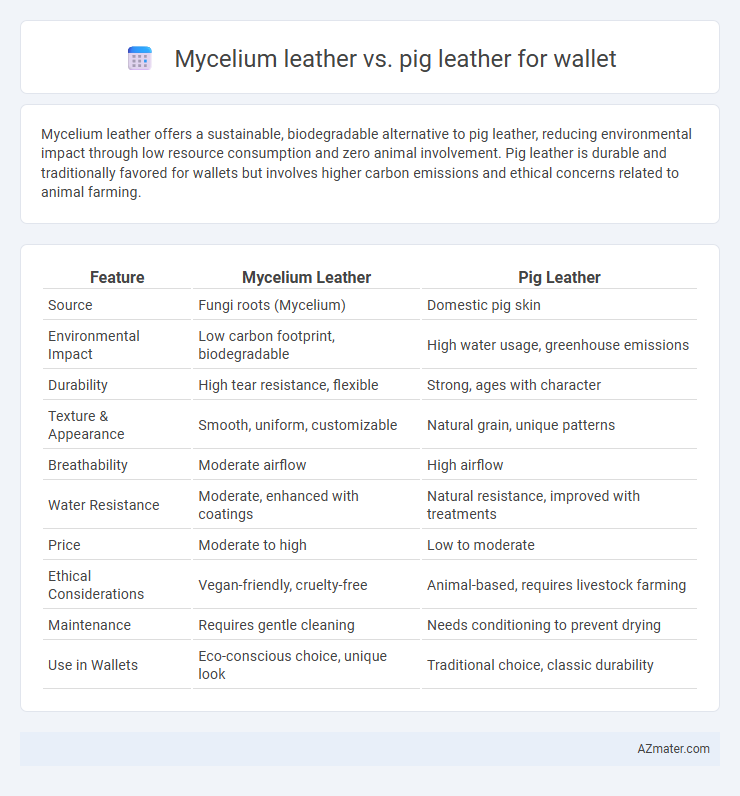Mycelium leather offers a sustainable, biodegradable alternative to pig leather, reducing environmental impact through low resource consumption and zero animal involvement. Pig leather is durable and traditionally favored for wallets but involves higher carbon emissions and ethical concerns related to animal farming.
Table of Comparison
| Feature | Mycelium Leather | Pig Leather |
|---|---|---|
| Source | Fungi roots (Mycelium) | Domestic pig skin |
| Environmental Impact | Low carbon footprint, biodegradable | High water usage, greenhouse emissions |
| Durability | High tear resistance, flexible | Strong, ages with character |
| Texture & Appearance | Smooth, uniform, customizable | Natural grain, unique patterns |
| Breathability | Moderate airflow | High airflow |
| Water Resistance | Moderate, enhanced with coatings | Natural resistance, improved with treatments |
| Price | Moderate to high | Low to moderate |
| Ethical Considerations | Vegan-friendly, cruelty-free | Animal-based, requires livestock farming |
| Maintenance | Requires gentle cleaning | Needs conditioning to prevent drying |
| Use in Wallets | Eco-conscious choice, unique look | Traditional choice, classic durability |
Introduction to Mycelium and Pig Leather
Mycelium leather, derived from the root structure of mushrooms, offers a sustainable and eco-friendly alternative to traditional pig leather, which is made from the hide of pigs and involves intensive animal farming and chemical tanning processes. Mycelium leather boasts biodegradability, lower carbon footprint, and cruelty-free production, making it attractive for environmentally conscious consumers. Pig leather remains prized for its durability, natural texture, and long-lasting strength, commonly used in premium wallets but associated with higher environmental and ethical concerns.
Sustainability and Environmental Impact
Mycelium leather, derived from mushroom roots, offers a sustainable alternative to pig leather by significantly reducing carbon emissions and water usage during production. Pig leather involves intensive livestock farming, contributing to deforestation, methane emissions, and high water consumption, which negatively impact the environment. Choosing mycelium leather wallets supports eco-friendly practices and minimizes the overall ecological footprint compared to traditional pig leather.
Durability and Longevity Comparison
Mycelium leather demonstrates impressive durability due to its fibrous mushroom structure, resisting wear and tear while maintaining flexibility over time. Pig leather, known for its natural toughness and grain pattern, offers substantial longevity but can become stiffer with extended use. Both materials provide strong durability for wallets, but mycelium leather's sustainable production and resistance to cracking give it an edge in long-term performance.
Texture and Aesthetic Differences
Mycelium leather offers a unique, natural texture with a slightly fibrous and matte finish that evolves over time, contrasting with pig leather's smooth, dense grain and glossy surface. The aesthetic appeal of mycelium leather emphasizes eco-friendly and artisanal qualities, while pig leather showcases a traditional, polished look prized for its durability and classic elegance. Choosing between the two involves balancing modern sustainability trends of mycelium against the proven longevity and refined appearance of pig leather.
Production Processes Explained
Mycelium leather is produced through the cultivation of fungal mycelium, where networks of filaments grow on organic substrates, providing an eco-friendly and sustainable alternative free from animal farming impacts. Pig leather production involves the tanning and curing of pighide, requiring chemical treatments to preserve durability and texture, often leading to significant environmental pollution due to chemical runoff. The mycelium process significantly reduces water usage and greenhouse gas emissions compared to conventional pig leather production, making it a more environmentally sustainable choice for wallets.
Cost and Market Availability
Mycelium leather offers a sustainable alternative to pig leather, often priced higher due to innovative production methods and limited-scale manufacturing. Pig leather remains more cost-effective with widespread availability in the market, benefiting from established supply chains and mass production. Consumers seeking eco-friendly options may face higher costs and limited retail presence when choosing mycelium leather wallets compared to traditional pig leather counterparts.
Ethical and Animal Welfare Considerations
Mycelium leather, derived from mushroom roots, offers a sustainable and cruelty-free alternative to traditional pig leather, eliminating the need for animal slaughter and reducing environmental impact. Pig leather production involves raising and processing animals, raising significant ethical concerns related to animal welfare and factory farming practices. Choosing mycelium leather supports ethical consumerism by promoting biodegradable materials and minimizing harm to animals and ecosystems.
Performance in Daily Use
Mycelium leather offers superior breathability and water resistance compared to pig leather, making it more durable for daily wallet use. Pig leather is known for its natural texture and strength but tends to absorb moisture and wear faster over time, leading to visible creases and stiffness. Mycelium wallets maintain flexibility and resist odor buildup, enhancing long-term performance in everyday handling and exposure to various environments.
Maintenance and Care Requirements
Mycelium leather requires minimal maintenance, needing only occasional brushing and wiping with a damp cloth to preserve its natural texture and durability, making it highly resistant to stains and water damage. Pig leather demands more frequent care, including regular conditioning with specialized leather oils to prevent drying and cracking, along with protection from moisture to avoid stiffness and mold. Compared to pig leather, mycelium leather offers a more sustainable and low-maintenance option for wallets, reducing the need for chemical treatments and frequent upkeep.
Future Prospects in Wallet Manufacturing
Mycelium leather offers a sustainable and eco-friendly alternative to pig leather in wallet manufacturing, leveraging rapid growth cycles and lower environmental impact. Innovations in mycelium processing enhance durability and texture, positioning it as a promising material for future wallet designs. Increasing consumer demand for ethical products drives industry investment toward mycelium-based wallets, signaling substantial growth potential in the market.

Infographic: Mycelium leather vs Pig leather for Wallet
 azmater.com
azmater.com